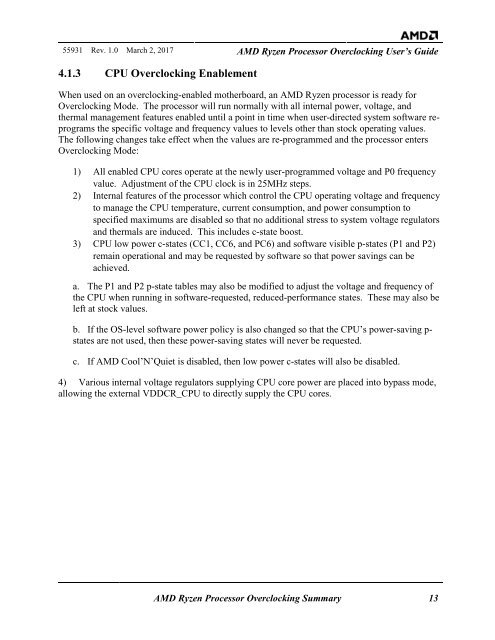AMD Ryzen Processor and AMD Ryzen Master Over-clocking User’s Guide
AMD-Ryzen-Processor-and-AMD-Ryzen-Master-Overclocking-Users-Guide
AMD-Ryzen-Processor-and-AMD-Ryzen-Master-Overclocking-Users-Guide
Create successful ePaper yourself
Turn your PDF publications into a flip-book with our unique Google optimized e-Paper software.
55931 Rev. 1.0 March 2, 2017 <strong>AMD</strong> <strong>Ryzen</strong> <strong>Processor</strong> <strong>Over</strong><strong>clocking</strong> <strong>User’s</strong> <strong>Guide</strong><br />
4.1.3 CPU <strong>Over</strong><strong>clocking</strong> Enablement<br />
When used on an over<strong>clocking</strong>-enabled motherboard, an <strong>AMD</strong> <strong>Ryzen</strong> processor is ready for<br />
<strong>Over</strong><strong>clocking</strong> Mode. The processor will run normally with all internal power, voltage, <strong>and</strong><br />
thermal management features enabled until a point in time when user-directed system software reprograms<br />
the specific voltage <strong>and</strong> frequency values to levels other than stock operating values.<br />
The following changes take effect when the values are re-programmed <strong>and</strong> the processor enters<br />
<strong>Over</strong><strong>clocking</strong> Mode:<br />
1) All enabled CPU cores operate at the newly user-programmed voltage <strong>and</strong> P0 frequency<br />
value. Adjustment of the CPU clock is in 25MHz steps.<br />
2) Internal features of the processor which control the CPU operating voltage <strong>and</strong> frequency<br />
to manage the CPU temperature, current consumption, <strong>and</strong> power consumption to<br />
specified maximums are disabled so that no additional stress to system voltage regulators<br />
<strong>and</strong> thermals are induced. This includes c-state boost.<br />
3) CPU low power c-states (CC1, CC6, <strong>and</strong> PC6) <strong>and</strong> software visible p-states (P1 <strong>and</strong> P2)<br />
remain operational <strong>and</strong> may be requested by software so that power savings can be<br />
achieved.<br />
a. The P1 <strong>and</strong> P2 p-state tables may also be modified to adjust the voltage <strong>and</strong> frequency of<br />
the CPU when running in software-requested, reduced-performance states. These may also be<br />
left at stock values.<br />
b. If the OS-level software power policy is also changed so that the CPU’s power-saving p-<br />
states are not used, then these power-saving states will never be requested.<br />
c. If <strong>AMD</strong> Cool’N’Quiet is disabled, then low power c-states will also be disabled.<br />
4) Various internal voltage regulators supplying CPU core power are placed into bypass mode,<br />
allowing the external VDDCR_CPU to directly supply the CPU cores.<br />
<strong>AMD</strong> <strong>Ryzen</strong> <strong>Processor</strong> <strong>Over</strong><strong>clocking</strong> Summary 13


